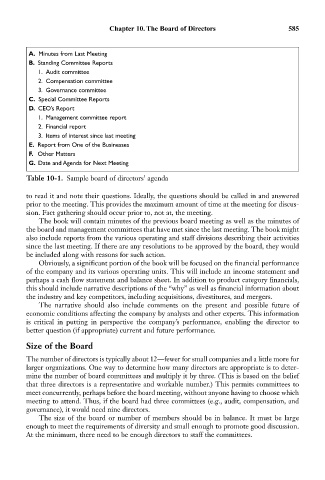Page 599 - Bruce Ellig - The Complete Guide to Executive Compensation (2007)
P. 599
Chapter 10. The Board of Directors 585
A. Minutes from Last Meeting
B. Standing Committee Reports
1. Audit committee
2. Compensation committee
3. Governance committee
C. Special Committee Reports
D. CEO’s Report
1. Management committee report
2. Financial report
3. Items of interest since last meeting
E. Report from One of the Businesses
F. Other Matters
G. Date and Agenda for Next Meeting
Table 10-1. Sample board of directors’ agenda
to read it and note their questions. Ideally, the questions should be called in and answered
prior to the meeting. This provides the maximum amount of time at the meeting for discus-
sion. Fact gathering should occur prior to, not at, the meeting.
The book will contain minutes of the previous board meeting as well as the minutes of
the board and management committees that have met since the last meeting. The book might
also include reports from the various operating and staff divisions describing their activities
since the last meeting. If there are any resolutions to be approved by the board, they would
be included along with reasons for such action.
Obviously, a significant portion of the book will be focused on the financial performance
of the company and its various operating units. This will include an income statement and
perhaps a cash flow statement and balance sheet. In addition to product category financials,
this should include narrative descriptions of the “why” as well as financial information about
the industry and key competitors, including acquisitions, divestitures, and mergers.
The narrative should also include comments on the present and possible future of
economic conditions affecting the company by analysts and other experts. This information
is critical in putting in perspective the company’s performance, enabling the director to
better question (if appropriate) current and future performance.
Size of the Board
The number of directors is typically about 12—fewer for small companies and a little more for
larger organizations. One way to determine how many directors are appropriate is to deter-
mine the number of board committees and multiply it by three. (This is based on the belief
that three directors is a representative and workable number.) This permits committees to
meet concurrently, perhaps before the board meeting, without anyone having to choose which
meeting to attend. Thus, if the board had three committees (e.g., audit, compensation, and
governance), it would need nine directors.
The size of the board or number of members should be in balance. It must be large
enough to meet the requirements of diversity and small enough to promote good discussion.
At the minimum, there need to be enough directors to staff the committees.

